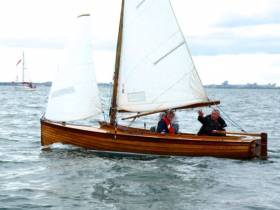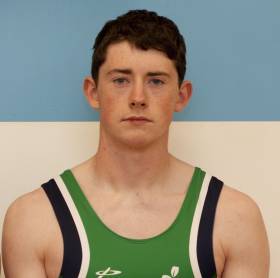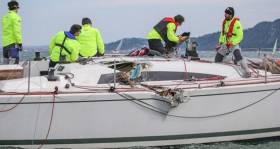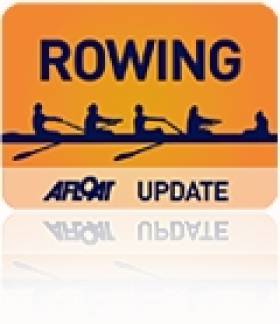Displaying items by tag: Regatta
Puspure and Friends Best at Boston Rowing Regatta
#Rowing: Sanita Puspure was part of the top women’s crew at the Head of the Charles Regatta in Boston. The Old Collegians rower took the honours in the Women’s Championship Eights, with a crew of the top scullers in the world, stroked by American Genevra Stone.
Paul and Gary O’Donovan finished second in their final race, the Directors’ Challenge Men’s Quads. The Skibbereen men teamed up with John Collins and Jonathan Walton of Leander to form a crew which they called Crossing the Pond.
Head of the Charles River, Boston (Irish interest; selected results)
Saturday
Men
Championship Doubles: 8 P O’Donovan, G O’Donovan 17 min 39.742 seconds.
Women
Championships Doubles: 1 K Brennan, E Twigg 18:08.7, 2 M Lobnig, S Puspure 18:20.219.
Sunday (Provisional)
Men
Directors’ Challenge Quads: 2 Crossing the Pond (G O’Donovan, J Walton, J Collins, G O’Donovan) 16:30.304.
Women
Championship Eights: 1 Cambridge (S Puspure, M Knapkova, M Lobnig, J Gmelin, C Zeeman, E Twigg, K Brennan, G Stone; cox: E Driscoll) 16:30.368.
For many years now the 1898-founded Howth 17s have spun quite an event out of their annual “National Championship” writes W M Nixon. It may only be a weekend series for a vintage one-design class at its home port, but they make it a three-day event by starting with an evening race on the Friday. As for the mid-championship dinner on the Saturday night, that has assumed epic proportions. And at one stage they found their owners and crews were giving such dedication to a weekend that concludes with a monster prizegiving Sunday lunch that they cheerfully referred to it all as the Howth 17 Worlds, from which title they had to be gently dissuaded (over time) by the National Authority.
Whatever it’s called, it’s a remarkable celebration of down home sailing, so inevitably last year HYC’s then Honorary Sailing Secretary Emmet Dalton got to thinking that, as all the on-water and shoreside infrastructure was in place for a proper championship, surely it made sense to see if other classic One-Design classes would like to be involved as well?
 The Mermaids – seen here racing at the Volvo Dun Laoghaire regatta - decided to make their National Championship 2016 part of the new Classic OD Regatta at Howth
The Mermaids – seen here racing at the Volvo Dun Laoghaire regatta - decided to make their National Championship 2016 part of the new Classic OD Regatta at Howth
The veteran Mermaid Class (which dates from 1932) didn’t merely rise to the bait. They swallowed it whole. And then they took some more, as they’re bringing their Mermaid Nationals 2016 to Howth from Thurday 4th to Sunday 7th August, thereby over-lapping the Howth 17 Championship from the Friday to Sunday.
The Mermaids are in fine form – as reported in Afloat.ie, they had an encouraging turnout of 18 boats for the recent Skerries Regatta. With the Mermaid contingent from Foynes planning on coming across country, and several times champion Jonathan O’Rourke of the National YC also emerging from Dublin Bay with his successful Tiller Girl, it will be an impressive fleet.
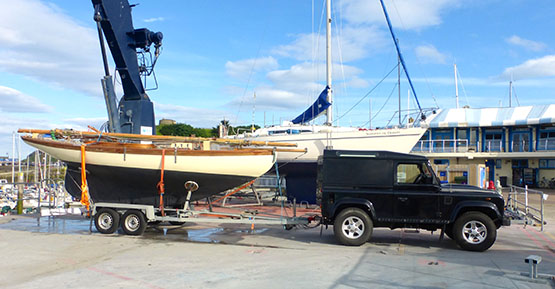
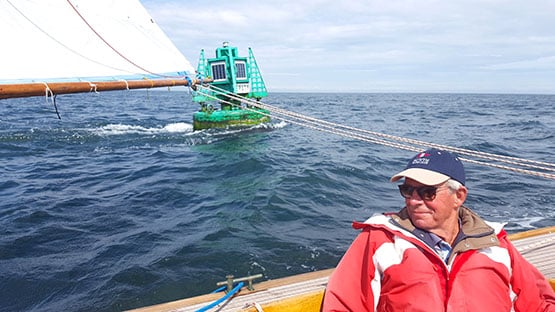 Not all the Howth 17s were road-trailed to Belfast Lough. The 1907-built Deilginis sailed there in two hops, with an overnight stop in Ardglass. Long-time Howth 17 veteran Nick Massey is seen here at the helm as Deilginis sweeps through Donaghadee Sound with a fair tide to enter Belfast Lough, and the GPS showing 8.2 knots over the ground. Photo: Davy Nixon
Not all the Howth 17s were road-trailed to Belfast Lough. The 1907-built Deilginis sailed there in two hops, with an overnight stop in Ardglass. Long-time Howth 17 veteran Nick Massey is seen here at the helm as Deilginis sweeps through Donaghadee Sound with a fair tide to enter Belfast Lough, and the GPS showing 8.2 knots over the ground. Photo: Davy Nixon
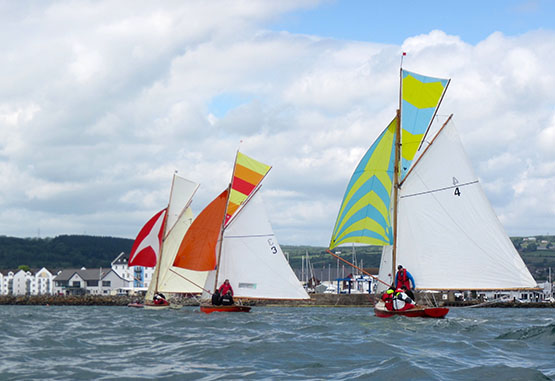
This in turn has upped the ante for the ancient Howth 17s. Recently returned from starring in the Royal Ulster YC’s 150th Anniversary celebrations on Belfast Lough, back in Howth they’ve been determinedly getting every Howth 17 in existence into commission and sailing in time for the weekend of 5th to 7th August.
This scheme has included allocating the current newest boat – the class-owned Sheila which was built over several years at a number of locations – to the new HYC Vice Commodore for the season, and as he happens to be Emmet Dalton who also has a foiling International Moth, he’s having a busy year of it.
But while some of the Howth 17s are maintained to classic yacht standards, others are in something of state of limbo both as regards ownership and readiness for sea. However, the community spirit of the Howth 17s is a wonder to behold, and through 2016 the pace of voluntary work has accelerated with a team co-ordinated by Ian Malcolm implementing an action plan to get boats fitted out and into the water. Any time now, with Bobolink being launched, we’ll see all eighteen Howth 17s afloat and sailing in time for the championship.


It will be a record for the class, but it will be a record which may well be beaten next year. Just this week Ian Malcolm – who already owns the 1898-vintage Aura – exchanged contracts and a deposit with Skol ar Mor in southern Brittany for a brand new Howth 17.
The people in the boat-building school at Skol ar Mor are no strangers to the Irish classic yacht scene, as last year they launched a new Water Wag, and before that they re-built the Dublin Bay 24 Periwinkle in immaculate style. So their take on a Howth 17 will be fascinating to behold.
But for now, attention is focusing ever more closely on what has become the inaugural Howth Classic One-Design Regatta from August 4th to 7th. With the Mermaids committed to bringing their own band for the Saturday night party, it will be quite something. And who knows, but next year it might entice other classes to get involved, leading on to even greater things.

#Rowing - The Carrick-on-Shannon Rowing Regatta will be held on Sunday 31 July on a 400m stretch of the waterway immediately south of the town bridge.
Hundreds of spectators and competitors are expected at the event, one of the final rowing events of the season, which is supported by Waterways Ireland through its sponsorship programme.
Events begin at 8am and will run till around 6pm. Craft wishing to make a through passage will be facilitated every two hours (approx) during the course of the regatta. Mooring restrictions will apply in Carrick-on-Shannon to facilitate the regatta.
In the interest of marine safety and to facilitate the laying of the competition course, access to the floating moorings will be restricted in the run-up to and during the event itself.
Only vessels of an overall length of 22ft/6.8m or less will be permitted on the floating jetties from Friday 29 to Sunday 31 July. Vessels berthed from Friday 29 July at 4pm will be required to remain in place until racing finishes on the Sunday evening.
The floating jetties will be closed off during this time and no vessels should approach as the entrance to the berths will be closed off and manoeuvring room will be severely restricted due to the proximity of the course. Access to the floating jetties will be monitored from Monday 25 July.
Masters are advised to proceed at slow speed and with due caution and to take note of advice from course marshals when passing through the area.
Further information can be had by contacting the Waterways Ireland inspectorate at +353 (0)87 985 2324 or North Shannon operations at +353 (0)71 96 50787.
NUIG Best Eight at Sun-Blessed Lough Rynn Regatta
#Rowing: NUIG won a two-boat battle with Commercial in the men’s senior eights final at the inaugural Lough Rynn Regatta in Leitrim today. The young crew had just under two lengths to spare. Daire Lynch of Clonmel and Ronan Byrne of Shandon won the men’s senior double – a notable victory for this junior crew as they set out to prove their capacity to the Ireland selectors. Portora had an excellent day, with their club one eight being the best women’s crew. The regatta was a success and was run in spectacular conditions, with bright sunshine and calm water.
Lough Rynn Regatta, Saturday – Selected Results
Men
Eight - Senior: NUIG A. Intermediate: Portora. Jun 18A: Portora. Jun 16: Portora. Jun 15: St Joseph’s. Masters: Commercial/Sligo/Tribesmen. Mixed Invitational: Portora A.
Four – Senior: NUIG A. Jun 18A, coxed: Pres, Cork A. Jun 16, coxed: Portora. Invitational: Galway D204.
Pair – Senior: Commercial A. Inter: Portora. Jun 18A: Clonmel.
Sculling, Quadruple – Club One, coxed: Neptune. Nov: Neptune B. Jun 18A: Three Castles. Jun 16: Commercial. Jun 15: St Joseph’s.
Double – Senior: Clonmel/Shandon (D Lynch, R Byrne). Club One: Sligo. Jun 18A: Commercial. Jun 16: Col Iognaid.
Single – Senior: Garda (D Kelly). Inter: Athlone (P Munnelly). Masters: Commercial (D Crowley). Jun 18A: Commercial (Beggan). Jun 16: Col Iognaid (M Ryder).
Women
Eight – Club One: Portora. Jun 18A: Portora. Jun 16: Col Iognaid.
Four – Inter, coxed: Portora. Club One, coxed: Commercial B. Jun 18A: Galway RC.
Pair – Sen: Bann. Inter: Bann.
Sculling, Quadruple – Club One: Commercial. Nov: Neptune A. Jun 18A: Bann. Jun 16, coxed: Galway RC. Jun 15, coxed: Commercial A.
Double – Club One: Univ of Limerick A. Jun 18A: Bann. Jun 15: Commercial A.
Single – Sen: Three Castles (B Quinn). Inter: Garda (B Larsen). Jun 18A: Neptune (C Feerick). Jun 16: Col Iognaid (C Nic Dhonncha).
Yachts Collide At Adriatic Regatta
#PesaroRovigno - This year's Pesaro-Rovigno regatta in the Adriatic was marked by a serious collision between two competing boats at the weekend, as the photo above shows.
According to Liguria Nautica News, Michele Cinquepalmi's 83ft Maxi Chica Magnum was on a starboard tack and Kuka, the Sly 42 of Roberto Casadei, was on a port tack when they collided at the pre-start on one of the two scheduled races of the Italy-to-Croatia regatta.
It's not yet known how the boats came to cross paths but the damage to the much smaller Sly 42 was significant, and some of its crew were treated for minor injuries after the larger vessel's hull created a deep gash in its starboard side.
Liguria Nautica News has more on the story HERE.
And here's video from on board Kuka which appears to be from shortly before the collision:
Rugby International Forces Further Date Change for Greystones Regatta
Plans to re–run August's abandoned Greystones Cruiser Regatta in October have changed slightly due to a conflict of dates with some sporting fixtures. While Sunday October 4 had been initially slated as the rescheduled date, organiser Daragh Cafferkey now says it will run on Saturday, October 3rd instead.
'We have been asked to avoid a clash with Sunday's Ireland v Italy Rugby International and accordingly we have opted for Sat afternoon with hopefully enough time for boats to comfortably make it over in the morning', Cafferkey told Afloat.ie
The August event attracted over 150 boats.
'We have many trophies, winners jackets, wine and other awards that remain unclaimed and accordingly we will rerun two short races or one longer race on Saturday with a warning signal of 14.25'.
All entries for Aug 30th remain live for this event but the freebee vouchers for burgers or berths are gone but a 50% discount will apply at Greystones Harbour marina.
Narrow Loss for Gallant Portora at Henley
#ROWING: Portora Royal School lost to Gonzaga College High School by half a length in the fastest race so far in the Princess Elizabeth at Henley Royal Regatta. The Enniskillen crew gave a remarkable display, refusing to let the bigger American crew extend their early lead to clear water. The crews overlapped down the course, with Portora mounting repeated pushes. Gonzaga finished well under pressure and won in a time of six minutes 38 seconds.
Henley Royal Regatta, Day Two (Irish interest)
Princess Elizabeth (Eights, Schoolboy): Gonzaga College High School, United States bt Portora Royal School ½ l, 6:38
Dun Laoghaire Regatta 2015 Sailing Instructions Online Here!
#Riverfest - The Dublin Bay Old Gaffers Association has timed its annual regatta to take place this weekend during the third Dublin Port Riverfest.
Weather permitting, the DBOGA will race in Dublin Bay for the Leinster Plate Trophy on Saturday 30 May, while on Sunday 31 May they will sail upriver to berth along the north quays and enjoy the festival's atmosphere before parading back to the Poolbeg Boat and Yacht Club.
Then on Bank Holiday Monday 1 June they will join an even bigger parade of sail to salute the departing tall ships – including the square rigger Kaskelot.
More details on the Old Gaffers' weekend plans – and how you can join in the fun – are available HERE.
And don't forget this summer's cruise in company along the 'Fastnet coast' in West Cork.
#Cullaun - The next big event on the Cullaun Sailing Club calendar is the Spring Regatta next weekend on Sunday 10 May.
That will see Wayfarers, GP14s, RS200s, Enterprises, Lasers and more racing, with visitors and club boats competing fiercely on the lake near Kilkishen in East Clare – which Commodore Jim O'Sullivan describes as one of the region's best-kept secrets.
Moer generally it's a busy time for Cullaun, with adult introductory sailing classes set to run over four consecutive Tuesday evenings starting 5 May.
Meanwhile, Sunday afternoon racing will move to Thursday evenings for the summer series, though junior sailing on the lake is still running on Sunday mornings.
The club says it looks forward to welcoming new sailors of all ages and abilities to get out on the water ahead of the new ISA 'Try Sailing' initiative in June. Further updates can be found on Facebook and Twitter.



























